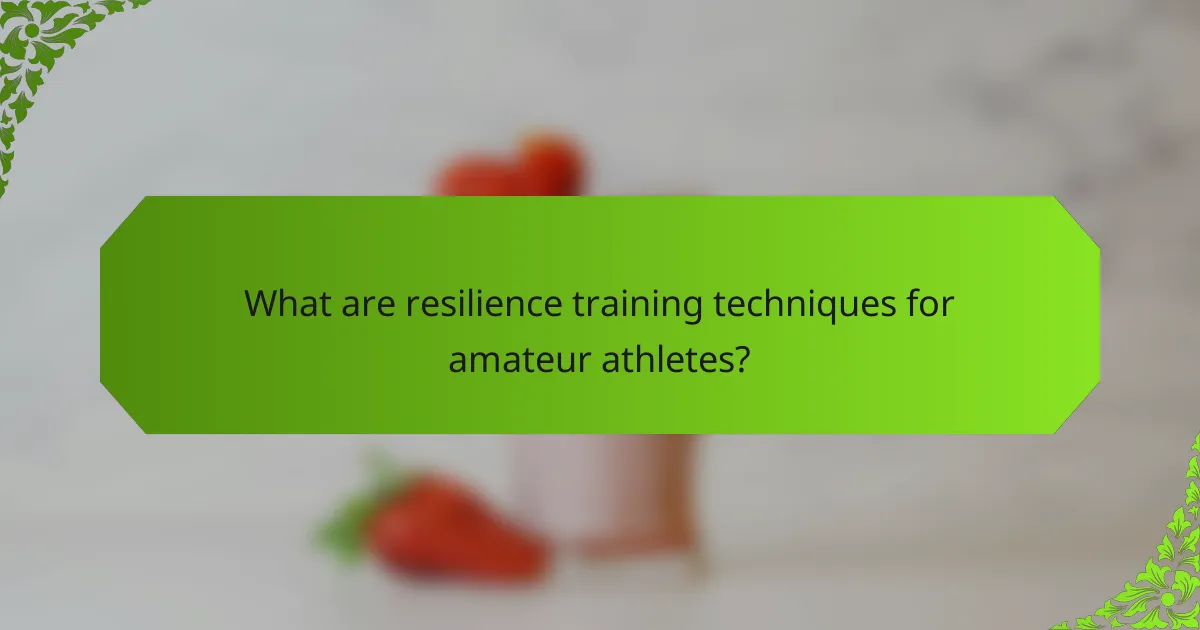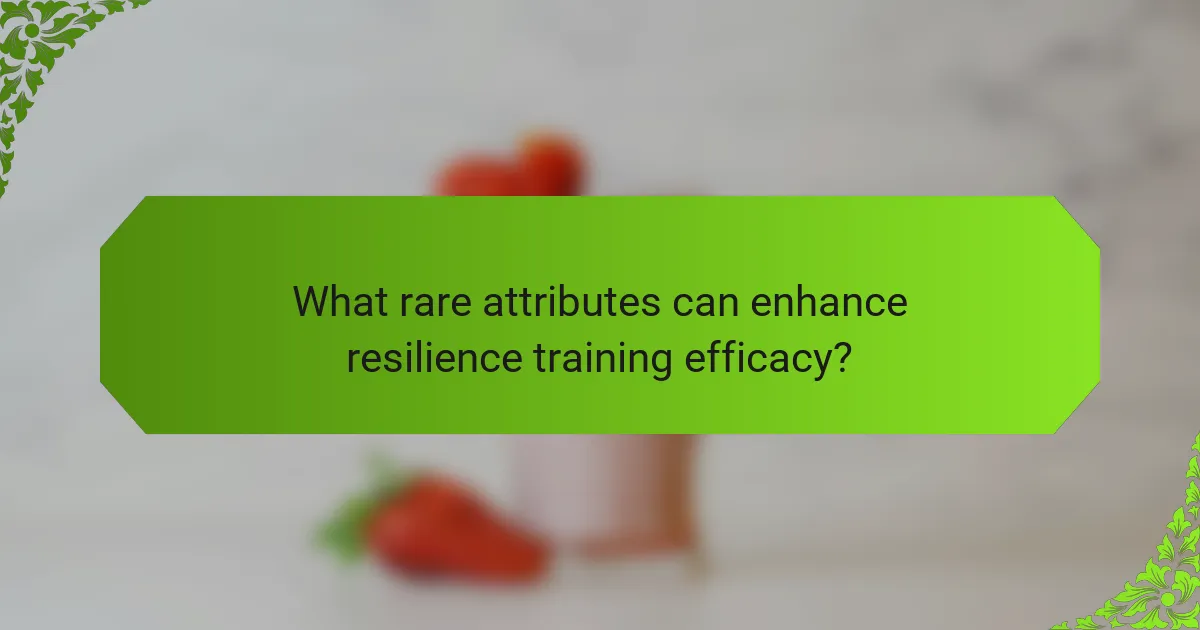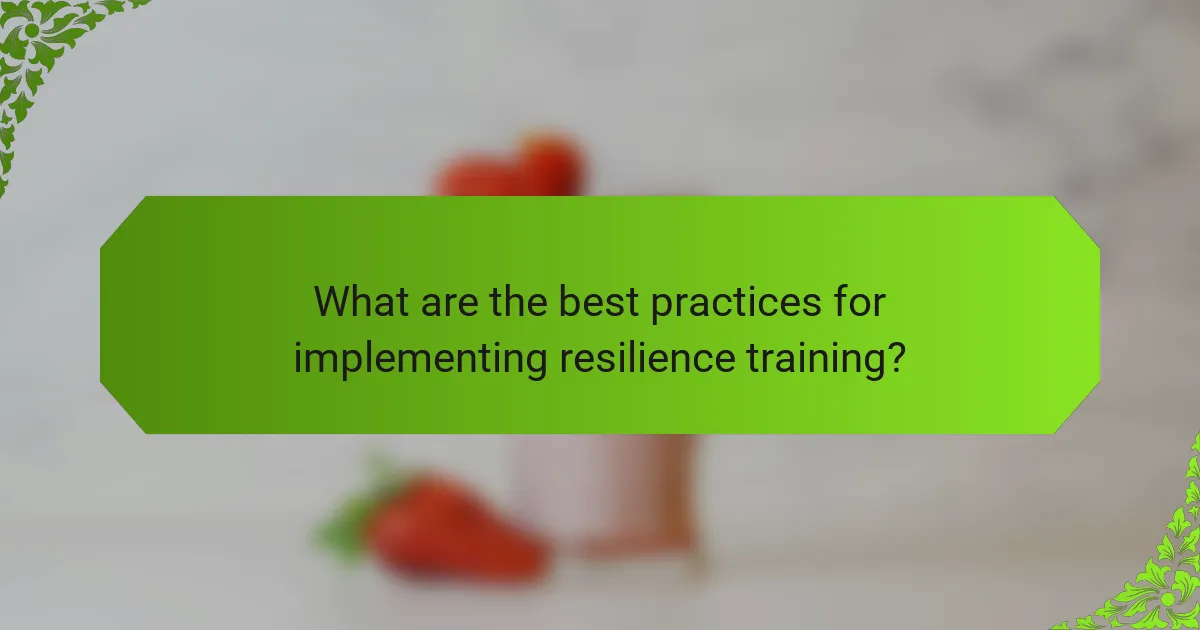Resilience training techniques enhance mental toughness and adaptability in amateur athletes. Key methods include visualization, positive self-talk, and goal setting. These techniques improve performance, reduce anxiety, and foster a positive mindset. Cultural perceptions also shape the effectiveness of resilience training, emphasizing the need for tailored approaches.

What are resilience training techniques for amateur athletes?
Resilience training techniques for amateur athletes focus on enhancing mental toughness and adaptability. Key methods include visualization, positive self-talk, and goal setting. Visualization helps athletes imagine successful performances, boosting confidence. Positive self-talk reinforces a growth mindset, encouraging perseverance. Goal setting provides clear objectives, fostering motivation and focus. These techniques contribute to improved performance and reduced anxiety during competitions.

What are the universal benefits of resilience training?
Resilience training offers numerous universal benefits for amateur athletes. It enhances mental toughness, improves stress management, and boosts overall performance. Athletes develop coping strategies, leading to greater focus during competitions. As a result, resilience training fosters a positive mindset, promoting long-term athletic success.
How does resilience training improve mental toughness?
Resilience training significantly enhances mental toughness by equipping athletes with coping strategies for stress. Techniques like visualization and positive self-talk foster a growth mindset, enabling athletes to persevere through challenges. Research shows that consistent practice can lead to improved performance under pressure, ultimately boosting confidence and focus. These attributes contribute to an athlete’s ability to handle adversity effectively.
What role does resilience training play in injury recovery?
Resilience training significantly enhances injury recovery by fostering mental strength and coping strategies. It equips amateur athletes with techniques to manage stress, maintain motivation, and build confidence during rehabilitation. Such training can lead to improved recovery times and reduced risk of re-injury. Techniques may include visualization, goal-setting, and mindfulness, which collectively support both physical and psychological healing processes.
How can resilience training enhance performance consistency?
Resilience training enhances performance consistency by equipping amateur athletes with mental strategies to manage stress and adversity. Techniques such as visualization, goal-setting, and mindfulness foster a positive mindset, enabling athletes to maintain focus under pressure. As a result, they can perform reliably, even in challenging situations. This consistent performance is crucial for skill development and competition readiness.

What unique methods are used in resilience training for amateur athletes?
Unique methods in resilience training for amateur athletes include mental imagery, mindfulness practices, and goal-setting techniques. Mental imagery helps athletes visualize success and cope with challenges. Mindfulness enhances focus and reduces anxiety, while goal-setting fosters motivation and a sense of achievement. These methods are tailored to individual needs, promoting both mental and physical resilience.
How does cognitive behavioral training contribute to resilience?
Cognitive behavioral training enhances resilience by equipping amateur athletes with tools to manage stress and setbacks effectively. This training focuses on identifying negative thought patterns and replacing them with constructive ones, fostering a growth mindset. The techniques improve emotional regulation, enabling athletes to bounce back from challenges more robustly. As a result, athletes experience increased confidence and motivation, which are crucial for long-term success in sports.
What is the impact of goal-setting strategies on resilience?
Goal-setting strategies significantly enhance resilience in amateur athletes by providing clear objectives and motivation. These strategies foster a sense of purpose, enabling athletes to navigate challenges effectively. Research indicates that specific, measurable goals lead to improved performance and mental fortitude. Additionally, regular goal evaluation helps athletes adapt and maintain focus, reinforcing their resilience over time.
How do visualization techniques assist in building resilience?
Visualization techniques enhance resilience by helping amateur athletes manage stress and improve focus. These methods create mental images of success, enabling athletes to visualize overcoming challenges. As a result, athletes develop a stronger mindset, which is crucial during training and competitions. Regular practice of visualization can lead to increased confidence and better performance under pressure.

What rare attributes can enhance resilience training efficacy?
Rare attributes that can enhance resilience training efficacy include personalized feedback mechanisms, which adapt to individual athlete responses, and cognitive flexibility training, fostering adaptability in unpredictable situations. Incorporating biofeedback devices can also provide real-time physiological insights, enhancing self-awareness and emotional regulation. Additionally, integrating mindfulness practices uniquely supports mental resilience, promoting focus and stress management. These attributes contribute to a more tailored and effective training experience for amateur athletes.
How do personalized resilience training programs differ from standard approaches?
Personalized resilience training programs focus on individual needs, while standard approaches apply generalized techniques. Personalized programs assess specific strengths and weaknesses, tailoring strategies for optimal performance. This customization enhances engagement and effectiveness, leading to improved mental toughness. Standard approaches may lack this adaptability, resulting in less impactful outcomes for amateur athletes.
What unique environmental factors influence resilience training outcomes?
Environmental factors such as climate, altitude, and social support significantly influence resilience training outcomes. For example, training in high-altitude environments can enhance physical endurance, while supportive communities can foster mental resilience. Additionally, exposure to diverse weather conditions may prepare athletes for competition variability. These factors collectively shape the effectiveness of resilience training techniques for amateur athletes.

How do cultural perceptions shape resilience training practices?
Cultural perceptions significantly influence resilience training practices for amateur athletes. These practices vary based on societal values, beliefs, and expectations surrounding mental toughness and emotional expression.
In cultures that prioritize collectivism, resilience training may focus on team dynamics and shared experiences. Conversely, individualistic cultures might emphasize personal achievement and self-reliance in training methods.
For example, in Eastern cultures, resilience training may integrate mindfulness and community support, while Western approaches often highlight competitive strategies and personal goal-setting.
Understanding these cultural nuances allows trainers to tailor resilience techniques effectively, enhancing their relevance and impact on athletes’ performance and mental well-being.
What regional variations exist in resilience training techniques?
Regional variations in resilience training techniques exist due to cultural influences and local practices. For example, Nordic countries emphasize mental toughness through outdoor activities, while Asian regions may incorporate mindfulness and meditation. These unique approaches reflect diverse values and environmental conditions, enhancing the effectiveness of resilience training.
How do local sports communities support resilience training?
Local sports communities enhance resilience training by fostering a supportive environment. They provide resources, mentorship, and opportunities for collaboration. These communities often organize workshops and training sessions that focus on mental toughness, stress management, and goal-setting techniques. Additionally, peer support systems within these groups encourage athletes to share experiences and strategies, reinforcing their ability to cope with challenges. Engaging in local competitions also builds resilience through exposure to pressure and the experience of overcoming setbacks.

What are the best practices for implementing resilience training?
To implement resilience training effectively, focus on structured techniques that enhance mental toughness. Key practices include goal setting, visualization, and mindfulness exercises. These methods foster adaptability, helping amateur athletes manage stress and improve performance. For example, incorporating scenario-based training can prepare athletes for real-life challenges, enhancing their resilience in competitive settings.
How can amateur athletes effectively integrate resilience training into their routine?
Amateur athletes can effectively integrate resilience training by incorporating specific techniques into their routines. These techniques include mental visualization, goal setting, and progressive muscle relaxation. Mental visualization helps athletes imagine success, enhancing confidence and focus. Goal setting provides clear objectives, fostering motivation and a sense of achievement. Progressive muscle relaxation aids in reducing stress, allowing athletes to recover better. Regular practice of these methods can significantly improve mental toughness and adaptability in challenging situations.
What common mistakes should be avoided in resilience training?
Amateur athletes should avoid common mistakes in resilience training, such as neglecting mental conditioning, setting unrealistic goals, and failing to track progress. These errors can hinder performance improvements and lead to burnout. Additionally, overlooking the importance of recovery and support systems can undermine resilience development.
How can athletes measure their resilience training progress?
Athletes can measure their resilience training progress by tracking specific performance metrics and psychological indicators. Key methods include monitoring recovery times, assessing mental toughness through self-report questionnaires, and evaluating consistency in training sessions. Regularly logging these parameters provides insights into improvements and areas needing focus. For example, a decrease in recovery time after high-intensity workouts indicates enhanced resilience.
What expert insights can enhance resilience training effectiveness?
Expert insights can significantly enhance resilience training effectiveness by incorporating psychological strategies, personalized feedback, and practical applications. Techniques such as cognitive restructuring help athletes reframe challenges positively. Regular assessments ensure training aligns with individual needs, fostering engagement. Real-life scenarios in training enhance adaptability, preparing athletes for unexpected pressures. Integrating mindfulness practices promotes mental clarity, aiding focus during performance.


